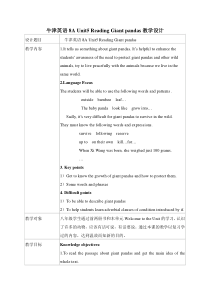 DOC
DOC
【文档说明】《Unit 5 Wild animals Reading 1 Giant pandas》教学设计5-八年级上册英语【牛津译林版】.doc,共(6)页,55.000 KB,由小喜鸽上传
转载请保留链接:https://www.ichengzhen.cn/view-102488.html
以下为本文档部分文字说明:
牛津英语8AUnit5ReadingGiantpandas教学设计设计题目牛津英语8AUnit5ReadingGiantpandas教学内容1.Ittellsussomethingaboutgiantpandas.It’shelpfultoenhanc
ethestudents’awarenessoftheneedtoprotectgiantpandasandotherwildanimals,trytolivepeacefullywiththeanimalsbecauseweliveinthesameworld.2.LanguageFocusTh
estudentswillbeabletousethefollowingwordsandpatterns.outsidebambooleaf…Thebabypandalooklikegrowinto…S
adly,it’sverydifficultforgiantpandastosurviveinthewild.Theymustknowthefollowingwordsandexpressions.survivefollowingreserveuptoont
heirownkill…for…WhenXiWangwasborn,sheweighedjust100grams.…3.Keypoints1)Gettoknowthegrowthofgiantpandasandhowtoprotectthem.2)Somewordsandphrases4.D
ifficultpoints1)Tobeabletodescribegiantpandas2)Tohelpstudentslearnadverbialclausesofconditionintroducedbyif.教学对象八年级学生通过前两册书和本单元Welc
ometotheUnit的学习,认识了许多的动物,应该有话可说,有话要说。通过本课的教学以复习学过的内容,达到温故而知新的目的。教学目标Knowledgeobjectives:1.Toreadthepassageaboutgiant
pandasandgetthemainideaofthewholetext.2.ToGetstudentstolearnsomewordsandphrases,gettoknowthegrowthofgiantpandasandhowtoprotectt
hem.3.Tohelpstudentslearnadverbialclausesofconditionintroducedbyif.Emotionobjectives:1.Toencouragethestudents
todoasmuchastheycantohelpthewildanimals.2.Toactivatethestudents’awarenessofprotectingwildanimalsandthenature.Abilit
yobjectives:1.Toimprovestudents’abilityofcommunication.2.Todevelopstudents’comprehensivelanguagecompetence.教学策略
1.Teachingaid:Amulti-mediacomputer2.Teachingapproach:CommunicativeApproachTask-basedLanguageApproachCo
operativeLanguageLearningApproach教学过程(可续页)教学步骤所用时间教师活动学生活动设计说明Pre-readingStep1.Revision1)Enjoyavideo2)Playaguess
inggame4分1)Playthevideoaboutanimalsforthestudents2)DescribedifferentkindsofanimalsEg:Thisanimalisfatandstrong,theywalk1)Enjoyt
hevideo,andthenlistasmanyanimalstheyhavenoticedastheycan.2)Guesswhattheanimalsare通过视频和游戏来复习学过的动物,不仅能给学生留下深刻的印象,激发他们的求知兴
趣,同时锻炼了学生的口语能力,调动了他们的学习积极性,让学生在轻Step2:LeadinginandpresentationWhile-readingStep3:ReadingandListening4分15分ontiptoe.Wh
ichanimalisblackandwhite,anditlivesonlyinChina?Thuspresentgiantpanda.Wheredogiantpandaslive?Thuspresentforest.Whatdogiantp
andaseat?Thuspresentbambooshootsandleaves.Inthisway,presentnewwordslikehunter,killandsurvive.1)Havestu
dentsquicklyreadthroughthetext,withtwosimplequestionsgiven.2)Dividethetextintotwoparts.Havestudentslistentothefirstpart.WhileListen
totheteachercarefullyandlearnthenewwordsactively.1)Readthetextquicklytofindtheanswerstothequestions.2)Lis
tenandwatchthevideoatthesametime.松愉快的氛围中复习了学过的各种动物。猜动物游戏以大熊猫结尾,自然过渡到本课主题。通过一环扣一环的提问,相继呈现需要学生掌握的词汇。这一环节能诱发他们的求知兴趣,牢固掌握生
词。在文章的处理上,我将全文分为两部分。先整体通读全文了解大熊猫的概况。再听第一部分关于大熊猫生长过程的录音,同时欣赏直观的熊猫成长视频。此时,我预先设计的两个问题Step4.Practice10分listening,enjoyavideoabout
ababypanda’sgrowth.3)Havestudentslistentotherestpart,withaquestiongiven:WhatproblemsmayXiWanghaveifsheisalone?1
)Putthesecondpartintoadialogue2)TellstudentsthatXiWanghascometousandholdaninterview3)Readthispartandtrytocompletethe
chartonthescreen4)Readitagainandtrytotalkaboutthechartintheirownwords.5)Trytofindthethreeproblems.Thenreadth
ispartandfindtheactionstoprotectgiantpandas.6)Thendiscussandthinkofmoreactions.1)Practicereadinginpairs,thenactoutthedialogue2)OnestudentactasXiWa
ng,alltheothersactasinterviewersand促使学生听和看时紧张思索,这样就紧紧抓住了学生的注意力,避免他们感到听得乏味。在回答问题的同时学生又锻炼了听力和口头表达能力,提高了逻辑思维能力和语言运用能力。第二部
分是大熊猫独立生活后可能遇到的问题。我要求学生通过听和仔细的反复的阅读来自己找出各种问题,并小组讨论来发现更多的威胁。这样的处理方法激发了学生的学习热情,让每个人都参与到课堂中来,同时又锻炼了他们的自学能力和口语能力。通过改编对话,采访,小组讨论,有节
奏的吟唱等环节的设计,进一步提炼出文章的重点和难点,帮助学生理解。特别是采访这一环节,由于加入了抢答加分的Post-readingStep5.Activate(Discussionandchant)Step6.Consolidation(Exercisesand
homework)8分4分1)Holdafurtherdiscussion:WhydowecallherXiWang?Findanothernameforher.2)AChant.Explaintheexercisestothestudents.askheranyquestiontheyarein
terestedin.1)Discussheatedly.2)Chantwithemotion.1)Fillinthemissingwordsaccordingtothetext.2)Designtheposterafterclass.方式,进一步激发了学生的热情,将整节课的气氛推向了高潮。对
文章主体内容处理完毕之后,我选用了集体讨论和有节奏的吟唱的形式,给每个学生表达自己观点的机会,拓宽学生的思路,引导学生探讨出希望这一名字背后的隐含意义,唤起学生保护野生动物,爱护大自然的情感。通过根据课文内容缺词填空这一题型有效地检验了本节课学生的掌握情况,而设计海报这
一独具创意的家庭作业,将学习活动延伸到了课外。教学反思这节课的教学目标是了解大熊猫的生长过程和面临的危险。具体涉及语言、技能、策略、情感等方面内容。语言知识包括outsidebambooleafThebabypandaloo
klikegrowintoSadly,it’sverydifficultforgiantpandastosurviveinthewild.等四会内容。还有survivefollowingreserveup
toontheirownkill…for…WhenXiWangwasborn,sheweighedjust100grams.等三会内容。语言技能是学生们能用这些语言知识来谈论保护大熊猫。情感态度方面主要是培养学生热爱野生动物,热爱大自然。学习策略方面要学生通过in
dividualwork,pairwork和groupwork等主动高效地学习,除了记住单词,理解文本内容外,还要善于把握交流机会,学会计划,实施和反思。本课是一篇介绍大熊猫的科普文章,我在备课时增加了watchingthevideos,
guessinggame,makingupdialogues,interview,chant,discussion等活动,不但满足了学生的表演欲望,还可以激发学生的灵活性和创造性,提高他们的逻辑思维能力和语言运
用能力,培养学生的人际交往能力和语言综合运用能力。尤其是视频加游戏导入和采访这两个环节,深受学生的喜爱,不仅活跃了课堂气氛,同时还有助于学生对知识的掌握和能力的培养。这样充满“乐”感的课堂,让学生感悟知识的
价值,使学习变得有趣,课堂也成为了师生互动的课堂。方法是教学的成败之关键。在教学实践中所运用的方法和模式都不会仅仅限于一种。这不仅是教学的需要,也是学习者心理的需要。在本课中我交替使用了听说法、交际法、视听法、多媒体教学法和任务型教学法,做到动静结合,有张有弛
,让学生始终保持良好的学习状态。总的来说,这是一堂比较成功的课,对于我今后的课堂也有很多的启示。我还要更细心的观察平时的每一节课,进一步的提高自己的教学水平。
 辽公网安备 21102102000191号
辽公网安备 21102102000191号
 营业执照
营业执照